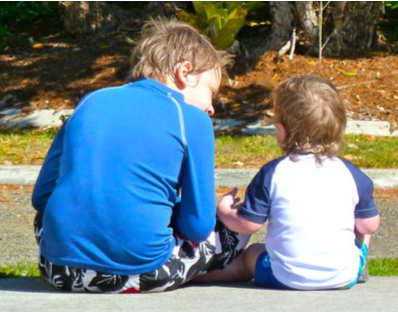4.21: Sibling Relationships
Siblings spend a considerable amount of time with each other and offer a unique relationship that is not found with same-age peers or with adults. Siblings play an important role in the development of social skills. Cooperative and pretend play interactions between younger and older siblings can teach empathy, sharing, and cooperation (Pike, Coldwell, & Dunn, 2005), as well as, negotiation and conflict resolution (Abuhatoum & Howe, 2013). However, the quality of sibling relationships is often mediated by the quality of the parent-child relationship and the psychological adjustment of the child (Pike et al., 2005). For instance, more negative interactions between siblings have been reported in families where parents had poor patterns of communication with their children (Brody, Stoneman, & McCoy, 1994). Children who have emotional and behavioral problems are also more likely to have negative interactions with their siblings. However, the psychological adjustment of the child can sometimes be a reflection of the parent-child relationship. Thus, when examining the quality of sibling interactions, it is often difficult to tease out the separate effect of adjustment from the effect of the parent-child relationship.

While parents want positive interactions between their children, conflicts are going to arise, and some confrontations can be the impetus for growth in children’s social and cognitive skills. The sources of conflict between siblings often depend on their respective ages. Dunn and Munn (1987) revealed that over half of all sibling conflicts in early childhood were disputes about property rights. By middle childhood this starts shifting toward control over social situation, such as what games to play, disagreements about facts or opinions, or rude behavior (Howe, Rinaldi, Jennings, & Petrakos, 2002). Researchers have also found that the strategies children use to deal with conflict change with age, but that this is also tempered by the nature of the conflict.
Abuhatoum and Howe (2013) found that coercive strategies (e.g., threats) were preferred when the dispute centered on property rights, while reasoning was more likely to be used by older siblings and in disputes regarding control over the social situation. However, younger siblings also use reasoning, frequently bringing up the concern of legitimacy (e.g., “You’re not the boss”) when in conflict with an older sibling. This is a very common strategy used by younger siblings and is possibly an adaptive strategy in order for younger siblings to assert their autonomy (Abuhatoum & Howe, 2013). A number of researchers have found that children who can use non-coercive strategies are more likely to have a successful resolution, whereby a compromise is reached and neither child feels slighted (Ram & Ross, 2008; Abuhatoum & Howe, 2013).
Not surprisingly, friendly relationships with siblings often lead to more positive interactions with peers. The reverse is also true. A child can also learn to get along with a sibling, with, as the song says “a little help from my friends” (Kramer & Gottman, 1992).

